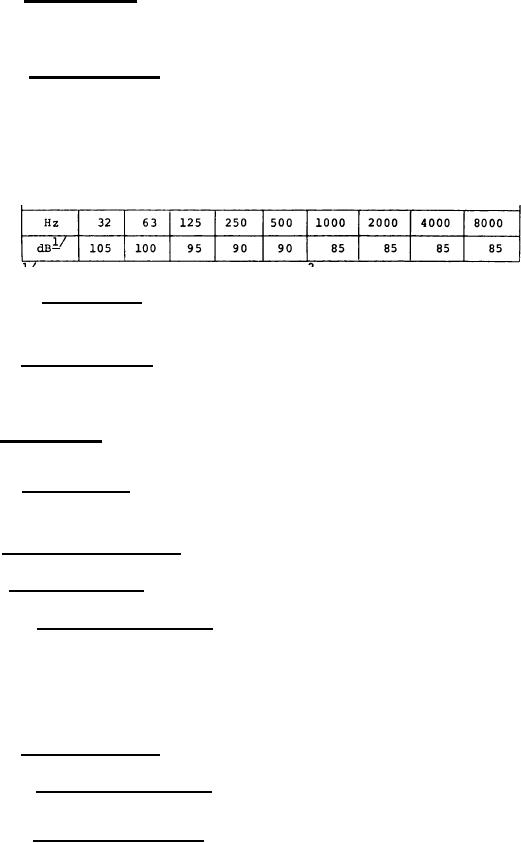 |
|||
|
Page Title:
Table III - Permitted airborne noise levels |
|
||
| ||||||||||
|
|  MIL-E-23457B(SHIPS)
3.8.6 Exhaust system. Exhaust headers shall be fresh water cooled, insulated, or
#
shielded. Asbestos insulating products and materials shall not be used. Provisions shall
be made for draining the gas spaces or the header from either end. When required to be
furnished with engines ((see 6.2.1), exhaust mufflers shall be in accordance with 3.8.6.1 and
3.8.6.1.1).
3.8.6.1 Exhaust mufflers. Mufflers shall be capable of reducing the overall noise of
#
exhaust gases to the maximum decibel (dB) levels indicated in table III. The sound pressure
levels shall be measured at a radius of 10 feet from the end and 2 feet above the muffler
tail pipe with the engine running at rated-load and speed. Installed mufflers, including
gaksets and hardware, shall be capable of withstanding a temperature of 1200F for a period
of 10 minutes. On or more cleanout openings, approximately 6 by 8 inches, shall be provided
if the diameter of the muffler is 25 inches or larger.
Table III - Permitted airborne noise levels.
Center frequencies of standard octave bands (Hertz (Hz))
In dB referred to as 0.0002 dynes/cm2.
3.8.6.1.1 Dry mufflers. The muffler shall be the dry type with spark arrestor. All-
#
metal parts shall be constructed of carbon steel ceramic coated in accordance with type II
of MIL-C-81751. Drains for removal of water and oil and a soot collector for removal of
carbon particles shall be included.
3.8.6.2 Exhaust emission. The engine shall keep exhaust smoke emission to a minimum.
#
The Ringlemann smoke chart shall be the standard of comparison. During normal, constant
operation at rated-speed, the smoke opacity shall not exceed Ringlemann No. 1. During a
speed change, smoke opacity may exceed Ringlemann No. 2 for 5 seconds, then gradually return
to less than Ringlemann No. 1 in less than 30 seconds.
3.8.7 Air starting. The air starting system for the engine shall consist of the
#
starting motor or distributor, relay valve, manually operated control valve, and the
necessary lines, connections, and fittings.
3.8.7.1 Cold starting. When tested in accordance with 4.4.2.4, the engine shall fire
#
and continue to operate within 10 seconds after the starting mechanism is actuated. If
cold starting aids are required, the identical starting aid equipment used during the tests
-
shall be furnished as part of the complete package under the contract or order.
3.8.8 Speed governing system. Engines shall be equipped with a speed governing system
#
and an indedepently driven ver-speed device. Governors shall be as specified (see 6.2.1).
3.8.8.1 Type I governors. Type I governors shall be furnished for constant speed
#
engines.
3.8.8.1.1 Steady-state stability. When operating at all loads up to rated-load, the
#
speed for any constant load shall be so controlled that the periodic or aperiodic oscilla-
tions of speed shall be not greater than plus or minus 0.50 percent of rated-speed.
The
response
of
the
governor
shall
be
such
that
upon
#
sudden application or loss of rated-load, the maximum momentary decrease or increase in
speed shall not exceed 7 percent of rated-speed. In addition, the engine r/rein shall
return to and remain within 1 percent of the final steady-state speed in not more than 5
seconds following a change in load.
Type II governors shall be furnished for variable speed
3.8.8.2 Type II governors.
#
--
engines.
3.8.8.2.1 Steady-state stability. When operating at all speeds and loads up to
#
rated-load and speed, the periodic or aperiodic oscillations of speed shall be not more
than plus or minus 1 percent of operating speed.
3.8.8.2.2 Momentary speed surge. The maximum deviation from normal speed, when full
#
or partial rated-load is applied or removed suddenly, shall not exceed 10 percent of oper-
ating speed. The speed shall return to plus or minus 1 percent of operating speed in not
more than 15 seconds following the change in load.
15
|
|
Privacy Statement - Press Release - Copyright Information. - Contact Us |